Retriever Breeds
Golden Retriever
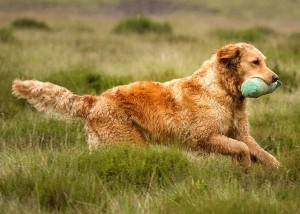
Photo courtesy Sue Worrall
An increasing interest in dogs that could retrieve shot game during the mid 1800s – dogs that could scent, forge through undergrowth, swim well, yet be soft mouthed and gentle whilst retrieving – lead Lord Tweedmouth to breed a yellow wavy-coated retriever dog called Nous with a liver coloured water spaniel called Belle. They produced four puppies.
Subsequent cross breeding with black labradors, water spaniels, and setters resulted in a flat coated retriever, yellow in colour, which was eventually recognised as a separate breed – the Golden Retriever. An exceptional retriever of game – the breed is also very popular both as pets and as show dogs. Golden Retriever Club website: http://www.thegoldenretrieverclub.co.uk
Labrador Retriever
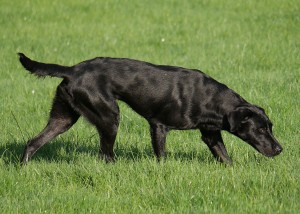
The original Labrador Retriever was an all-purpose water dog which originated from Newfoundland, not Labrador. Research shows that in the early 1800s it came in different sizes including a medium sized “Lesser” or “St. John’s” Newfoundland – the ‘little black water dog’ – the earliest incarnation of the Labrador. These black close haired dogs retrieved game and fish, hauled nets, and helped fishermen with any task that involving swimming. Eventually breed numbers bagan to dwindle in Newfoundland – largely due to the belief that some fishermen allowed their dogs to roam when they were not being used on ships or to assist in hauling or hunting. Sheep farmers would suffer attacks from these hunting and working dogs – and this was countered by the introduction of The Sheep Protection Act of 1885. However a number of Labradors had been taken to England in the early 1800s, and it is from these dogs, along with crosses to other retrievers, that the breed continued. It was also in England that the breed earned its reputation as an extraordinary retriever of game. Labrador Retriever Club website: http://www.thelabradorretrieverclub.com
Curly Coated Retriever
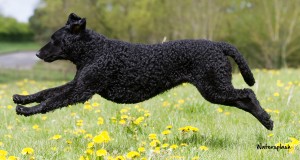
Photo courtesy Sue Worrall
The curlycoat is one of the oldest of the retriever breeds and it’s origins are thought to have stemmed from cross breeding of the Old English water dog, the Irish Water Spaniel and a small Newfoundland breed. The combination of such water retrieving heritage resulted in an exceptional water retriever. Later cross breeding with the poodle resulted in a tighter curly coated characteristic. Curly Coated Retriever Club website: http://www.curlycoatedretrieverclub.co.uk
Flat Coated Retriever
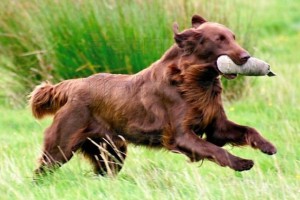
Photo courtesy Caroline Hewison
The ‘little black water dogs’ of Newfoundland were unrivaled swimmers and natural retrievers, and crosses between them and British breeds, such as setters or pointers, honed the dog’s bird sense. The result was the wavy-coated retriever which became quite popular in America and England. In fact, it was among the earliest breeds to be shown at English dog shows. Near the end of the 1800s, crosses with a straighter-haired breed were made because the wavy coat was thought to be less water-repellent. The combination resulted in the Flat coated Retriever. Flatcoated Retriever Society’s website: http://www.flatcoated-retriever-society.org
Nova Scotia Duck Tolling Retriever
Tolling (Middle English meaning: to lure or decoy) is done by dogs running along the shore line, chasing sticks, tail wagging, and occasionally disappearing from sight – an activity that would draw curious ducks to the area. This activity would continue though the dogs would continue to ignore the ducks. The ducks were then shot and the dogs sent to retrieve them. Such decoy dogs may have come with European settlers to the New World, where they were used to toll from the Chesapeake Bay to the Maritimes. The Nova Scotia Duck Tolling Retriever was developed in Yarmouth County, at the southern tip of Nova Scotia, in the early 19th century. It may have been derived from the red European decoy dog and perhaps later crossed with spaniel, setter, or retriever-type dogs, as well as farm collies. An alternative theory is that they are derived in part from tolling American Indian dogs. Originally known as the Little River Duck Dog or the Yarmouth Toller, the breed later became known as the Nova Scotia Duck Tolling Retriever. Nova Scotia Duck Tolling Retriever Club UK website: http://www.toller-club.co.uk
Chesapeake Bay Retriever
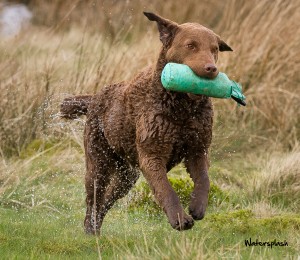
Photo courtesy Sue Worrall
In 1807, an American ship rescued the crew and cargo from a shipwrecked English brig off the coast of Maryland. Among the rescued were two presumably Newfoundland pups that were given to the rescuers. These pups (one black and one red) later proved to be skilled water retrievers, and as their reputations grew, many local retrievers of uncertain background came to be bred from them. It is also thought that Irish water spaniel, Newfoundland, bloodhound and other local hound crosses added to the breed’s development – resulting in a dog that would unerringly retrieve from the rough icy waters of the Chesapeake Bay. The Chesapeake Bay Retriever looks roughly similar to the Labrador Retriever in size and shape. Their coats are brown or sage in colour, and may contain white spots. Their coats are slightly longer in places than the Labrador Retriever coat, having a slightly curly or wavy appearance on the shoulders. Chesapeake Bay retriever Club website: http://www.chesapeakebayretrieverclub.co.uk
Irish Water Spaniel
The Irish Water Spaniel is one of the oldest and most distinctive spaniels. Dogs resembling them are depicted in manuscripts from 1,000 years ago. In the 1100s, mention is made of dogs called Shannon Spaniels, rat-tail spaniels, whip-tail spaniels or Irish Water Spaniels. Continued references to the Irish Water Spaniel can be found from 1600 onwards. It is believed that the history of the Irish Water Spaniel also concerns several similar breeds of spaniel that existed in Ireland: the Northern Irish, Southern Irish, and Tweed spaniels. The Southern Irish spaniel, also called McCarthy’s Breed, is credited with being the eventual major forebear of today’s dogs. In the mid-1800s, the appearance of the prolific sire Boatswain so influenced the breed that he is often credited as being the forefather of the modern Irish Water Spaniel. Sporting Irish Water Spaniel Club website: http://www.siwsc.org.uk
